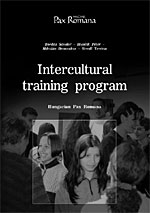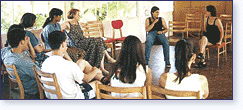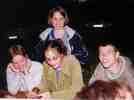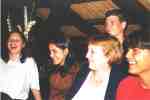
(Letölthető: pdf formátumban, 430 kB)
The Catholic organization Hungarian Pax Romana (HPR), in collaboration with the trainers of the Marai Sandor Foundation, has worked out a program that would ideally help societies to have a more open attitude towards their minorities. The realization and success of such program would have a significant effect on the integration of the various minority groups. Regarding the Roma population of Hungary, the majority of the initiatives aiming to help the Roma population of Hungary either try to improve their living conditions or encourage respect and acceptance toward the Roma. The program of the Hungarian Pax Romana, however, takes these steps further by focusing on the Roma individual, thus commencing the integration process on an inter-personal level.
The program presented in this booklet was carried out with the participation of the Gandhi Roma High School in Pécs and numerous Catholic high schools throughout the country. We hope that the acquaintance of our program will encourage international cooperation.
The HPR started its Roma project in 1998. Our goal was to find explanation - from a specifically Christian and intellectual point of view - for the social problems of the Hungarian Roma population. Most of the previously conducted studies provided insights on legal, sociological, political and pedagogical levels, yet they failed to offer an explanation from the individual's perspective. The communication training program of the HPR on the other hand was carried out with the participation of both Roma and non-Roma individuals, thus carefully considering both standpoints. This research is extremely important for two main reasons. First, because it provides us with a better understanding of the two sides, and secondly, the results can positively affect the social integration as they have the potential to reduce the prejudices and conflicts that otherwise impede the relationship between individuals.
 |
 |
 |
What are gypsies like? What are your experiences with gypsies? In 1999, we asked these two questions from students who attended catholic school.
What are gypsies like?
It is commonly known that the majority of gypsies are unemployed for a good reason: they are not fond of work (even in the past they only played music, but this is out of fashion now), they live on welfare paid by other Hungarians in the form of taxes, yet they remain ungrateful. They are offensive against the Hungarians. Soon the number of gypsies will outgrow the Hungarian population (so far this proportion has only been valid in jails). This country will soon become a gypsy country! They are way too unfitting for this society, and also for the EU!
A true story
The following story happened to me when I was 6. A friend and I were heading to his grandmother's on bike. We were crossing a gypsy populated area. One of the gypsy boys stopped us and wanted to borrow my bike. I naturally refused, therefore he slapped me and I started to cry. We did not know what to do, but we managed to get out of there. If I can recall this correctly, I have not told this story to anyone, since this was a very unpleasant experience for me.
The two examples mentioned above belong to the more "subdued" experiences people have with gypsies. Those students asked in the course of our training programs showed a very strong antipathy towards gypsies. The stories they tell are not their own but come mostly from family members; similarly, their opinions have been shaped by their close environment. In most cases, racist attitudes are present as it is evident from the radical suggestions the students had for solving the gypsy-issue: e.g. deportation to Romania or India. They also made the following observations: the number of gypsies will only increase (18), they live off welfare (17), they steal (15), they do not like to work (12), there are some nicer gypsies as well (12), they are sponsored by the state (11). Most of the observations referred to social behaviors and criminality (66 in total). Among the opinions there were only three that could be labeled as 'neutral' (excluding the one that "there are nicer gypsies as well"): they have different traditions (1), they are unemployed (6), people do not like them (3).
The attitude of the pedagogues does not differ from the students' substantially, except they do not practice open or aggressive racism. They are similar though, in that they have no adequate answers or practical guidelines for the students to handle their experiences. They know they must practice tolerance, but it all becomes theory when it comes to an actual situation, in which they are, unfortunately, helpless. It seems that the majority of the pedagogues do not see a role for themselves in the resolution of this conflict.
In class discussions about the Roma, similar reactions are very common among students. One would assume that the students learn their opinions from their parents only; however, there are numerous cases, in which these young people speak from their own experiences. For example, on one occasion a pupil, who came from a village where the gypsy and the non-gypsy inhabitants lived in constant fights, shared his feelings and experiences. He was convinced by what he saw on a daily basis and stated that there is not a single gypsy in his village who would be willing to work or study. He said this humbly with an unmistaken childish sincerity.
The students fully perceive these negative experiences, they have hard time understanding them and therefore, it is difficult for anyone to approach them purely on an intellectual level, especially regarding a taboo topic like the gypsy situation. However, deep inside they are extremely open for change.
The description above would not be complete if we did not mention briefly the segregation of students in public schools. In some towns, there is a variety of schools the parents can chose from to send their children. So, those who can afford it will send their children to 'better' schools that are almost always inaccessible for the poorer (e.g. Roma) children. One of the consequences of this is that the presence of Roma students in high schools is extremely low. This tendency was well represented in the high schools that applied for our training program, as they had only very few students of Roma origin.
 |
 |
It was a result of the previously mentioned survey of young individuals and the results that encouraged the implementation of communication trainings with Roma youth. Our rational was that by joining together Roma and non-Roma students, both parties would have to reconsider who the subject of their prejudice is. This would result in a personal experience, which would eventually make them think about the consequences of generalization and discriminative behavior.
Our idea was to step into the Roma conflict on a level that not many initiations have yet attempted to approach. This level would be best described as inter-personal communication, which has not been the typical approach of state organizations that tend to point out the negatively functioning aspects on a macro-structural level. While there is a willingness to solve the difficulties on this very level, unfortunately, the same is not true of the individual (inter-personal) level. Yet, it is at the inter-personal stage that we experience most conflicts regardless of whether we belong to the Roma or the non-Roma group. In HPR we believe that it is our moral obligation to do our best to solve the Roma conflict on an inter-personal level.
Let us, therefore, make this happen! Let there be a real meeting of young individuals! We are convinced that if the students will get a chance to see that there exists a "different kind of gypsies" than the ones they have had experiences so far (if they had any), then they may give up their rejection toward this minority group. A rejection, they practice almost instinctively, may be exchanged to the view that there is no point to differentiate between "decent" or "indecent" gypsies (as it is pointless to talk about good or bad Hungarians); rather there is a much more functional way of thinking, in which we acknowledge that they are human beings and as such, our evaluation of them should be based on their personal decisions as opposed to their origin per se. Furthermore, it should be the duty of every educational institution to teach students patience and tolerance, so that the students may learn empathy and acceptance toward the poor, the homeless, and develop the ability to recognize one's real self. In other words, let them see the human in all of us. This is a particularly difficult challenge for any educational institution in the modern Hungarian society.
To carry out the training program, we have asked the experts of the Marai Sandor Foundation in Slovakia for their assistance. Their expertise is evident as they conducted numerous trainings of this kind between the Slovaks and minority Hungarians in Slovakia. Their 100-hour training program was designed to investigate the inter-ethnic relations between Slovaks and Hungarians, which was also documented in an English publication. In addition, the MSF organized several Roma-Slovak-Hungarian training programs for the past few years, in which more than 600 volunteers participated. (Counter proof, NAP Publishing, 1996; Confidence Building in the Carpathian Basin, NAP Publishing, 2000; TAS, NAP Publishing, 2000.)
For our request, the MSF kindly re-designed its 100-hour program to a weekend-long workshop, which involved the participation of two Catholic schools and the Roma High School of Pécs, with the total number of 16 Roma and 16 non-Roma student participants.
Fortunately, all three high schools showed an immediate interest for the program. All of the students participated voluntarily. The most common element of motivation was their curiosity, but they were also eager to take the challenge they saw in this activity.
Our initial fear that the Roma students of the Gandhi High School would become subjects of offence and insult soon vanished - thanks to the proficiency of the trainers. The students soon realized that instead of being part of a problem they were active participants of communication training.
The first weekend of the training had a very powerful cathartic effect on the students. Their accounts of this weekend show confusion and shock; similarly, their families stood puzzled as the students could not quite express their feelings after returning to their homes. So, the students felt that they were left alone with their new experiences because they were unable to share them with their immediate environment. Seeing this, the HPR and MSF decided that it would be useful to expand the one-weekend workshop to a three-weekend workshop, which would give more opportunity to absorb and digest all the new "shocking" information.
Since the first student-training we have organized four more, always recruiting students from grade 11 of the above mentioned three high schools. We observed a gradual melting of tension as we moved from the very first training toward the last one. This can be partially explained by the fact that the participants of the first group had absolutely no idea about the program, whereas the later groups acquired information from their predecessors. Also, during the three weekends the students had the opportunity to interact more frequently, thus tune into each other. Interestingly, the last group seemed to be the most balanced, although the participants arrived to the training with no different attitudes than the previous groups'. Still, there were no major quarrels and fights, especially not ethnically driven. The students intermingled with each other much more freely from the very start and there was much less segregation than during the prior trainings. We asked the schoolteachers to follow the students' progress and they observed the positive change the participating students went through, however, they also witnessed the students' confusion and their initial negative emotions.
During those three years when the student trainings were conducted the collaboration between the schools was highly efficient. The teachers, who had experienced the benefits of our program, strongly encouraged the students to participate, which made for an easy recruitment. There were other schools outside the three participating ones where the director discounted the possibility of success saying that at an age of 16 a one-week workshop cannot make a difference. Thankfully, those instructors who saw the progress with their own eyes made a tremendous effort to continue and even expand the program.
The student training was carried out in two groups, where the number of boys/girls, Roma/non-Roma, was roughly evenly distributed. Both groups worked simultaneously and were joined together on some occasions.
The training took nine days to complete in such a way that the first two weekends were 2-3 weeks apart and they were followed by a 5-day more intensive workshop at the end. The activities went from 8 am to 8 pm with several pauses in between. The final 5-day workshop included some spare afternoons as well to allow the students to rest.
When choosing the venue we take special care to pick neutral locations such as high school residences or student camps. We also looked for places that offered a variety of group activities: beach, walking trails, sport, cooking, etc. For the workshop activities all we needed was a classroom, the necessary equipment was provided by our staff.
The financial costs of the program were all covered by HPR. These costs included a modest salary for the MSF trainers, rental fees for the venues, grocery and traveling expenses. The total cost for the training of 32 individuals was between €6000-8000. The HPR obtained this sum through local and international fundraising.
Since this program involved students, the presence of a teacher supervisor was also important. The teacher did not partake in the training and her attendance was ensured by the employer school.
The trainers were always Hungarian psychologists, and psychiatrists from Slovakia. In the course of the four trainings we had six trainers. We certainly planned to organize training courses for trainers in Hungary, however, because of the lack of applicants these trainings have not yet been carried out.
During the four trainings we had a chance to work with more than 100 young adults. This number was enough to get the attention of the participating schools and their teacher staff who soon demanded a continuation and a possible training for the teachers (certainly it would be lot more efficient if we could involve the teachers as they can have a huge impact on the students' thinking). Unfortunately, due to the lack of resources, we were unable to launch workshops during the past two years. This leaves us worried that the impact of the four trainings will gradually fade. It is also true that despite of their success, these first four trainings were not sufficient to bring along permanent change as it has been reflected in the students' experiences; after the first weekend they needed another two meetings to affirm their new skills and understandings.
The program has been introduced in a publication titled "Egyuttlet" ("Being Together"), Balassi Publishing - Hungarian Pax Romana, 2004. Several articles have also spread information about our trainings; however, we have not yet found partners who would be willing to sponsor our project. It is by now obvious that the project has outgrown HPR as a civil organization; nevertheless, we are enthusiastic to partake in future projects.
 |
 |
 |
The design of the training program does not make it suitable to host and train masses of people at once. Nonetheless, we do believe that its impact is powerful enough to reach crowds if it is done properly with skillful trainers and enthusiastic participants. The student trainings showed that the participation of 6-8 students each year made a noticeable difference in the school; they directed the attention of their peers and the instructors to the existing Roma conflict. They had the ability to make others re-evaluate and even change their attitude and thinking. That is why we feel it is important to remain present in these schools and further observe what the influence of our trainings on the environment is.
It is evident that our trainings can make a difference in the society; therefore, the most ideal participants would be those citizens who fulfill influential positions and have authority over the social mentality in Hungary.
Furthermore, it would be very exciting to apply this program to other minority-related projects that aim to make integration processes more feasible in other environments, as it has the power to enhance and motivate acceptance toward minorities in majority groups.
Although this program has been used to get to the bottom of the Roma conflict, it is designed in a very flexible way, which means that it could definitely be applied to other existing minority and religious conflicts.
HPR can offer a unique training program designed to effectively help the integration process of disadvantageous groups such as the Hungarian Roma. Our approach significantly differs from that of other initiatives. HPR would also be eager to support and supervise this program in the future. Also, HPR would be keen to organize workshops for future trainers as well as to pass on and improve the methodology with the assistance of dedicated experts who are ready to continue this project on a broader level.
HPR is looking for devoted partners who would like to use and improve this program, and who would be able to ensure the necessary conditions for its success.
Our training program grows out of the belief that in every personality there are characteristics that are stemming from the family and the small societies from the childhood (e.g. kindergarten, school). Based on their life experiences, people develop different perceptions of things and events. New information often gets filtered through people's established system of views. A person acts according to the values and norms of his or her culture; another person holding a different worldview might interpret his or her behavior from an opposite standpoint. This situation creates misunderstanding and can lead to conflict. Effective communication with people of different cultures is especially challenging. Cultures provide people with ways of thinking--ways of seeing, hearing, and interpreting the world. Thus the same words can mean different things to people from different cultures, even when they speak the "same" language.
The attitudes people learn in their families and cultures can be changed, or improved, with group trainings and therapies. Social skills like: effective behavior, communication, cooperation, and creating relationships can be also enhanced. Very often behind the occurring conflicts are incorrect attitudes, miscommunications, the distortion of transforming information and interpretation of information.
The target groups of our training programs aim at the improvement of inter-ethnic relations among teenagers. Teenagers are the group by which the "revolution of identification" can be best characterized. This is the most critical period in the formation/development of the identity. At this age the 'inherited' behavior patterns, and values can be confronted with the values and patterns of youth. These problems of identity are characteristic throughout puberty/adolescence; however, the most critical period is at the end of puberty. We believe that this period of the "revolution of identification" is the optimal time to stress the values of difference.
The training program we are using was developed by the Marai Sandor Foundation
(MSF-Slovakia) during 1998-2003. During this period they conducted intensive
workshops with the Roma in Slovakia. We started to cooperate in 2000 and that
was the time when the training was modified to fit the needs of HPR.
During the past ten years the MSF has worked in mixed ethnic groups (e.g. Slovak-Hungarian,
Roma-Hungarian, and Slovak-Roma). Working in these mixed groups helped them
to finalize the training program.
The Hungarian Pax Romana (HPR) understood the importance of this agenda and decided to closely collaborate with the MSF. So the following training program stems from this cooperation.
The training program is designed to pursue the following five topics:
1. Self knowledge
2. Communication
3. Assertiveness and conflict resolution
4. Tolerance
5. Team building
The trainers are basically psychologists, who have been specially trained in the Rogerian self-centered therapy as well as the psychodrama of Moreno.
Rogers was engaged in solving inter-ethnic conflicts using his method. According to Rogers the "self" plays a key role in conflicts. Only a person who lives in harmony with himself/herself can live in harmony with others.
According to Rogers humans are essentially good, filled with good values, intentions and possibilities. It is very difficult to accept people and nations who feel and think in a different way. As long as we are able to accept another person with his feelings, behaviors and beliefs that are forming his personality, we help this person to become a full human being and leave his faulty attitudes behind. Rogers believes that the more the person is accepted and understood by others, the more chances he has to improve his behavior and change his attitudes.
The trainers are aware that people can act out of fear and defense - cruelly, brutally, destructively and anti-socially. Very often behind these fears and defense mechanisms are "inherited" attitudes, prejudices and also lack of self-knowledge. One of the goals of our training programs it to understand these problems and eventually solve them. Inter-ethnic events and unfinished tasks/duties, according to the Zeigarnik effect, maintain tension. This tension is present as long as the event has ended and the tasks get completed. Also, these tensions are destructive in nature.
The second guiding principle for our training program is the Moreno-type psychodrama, which is based on human spontaneity and creativity. It is essential for the participants to relive real life experiences. Jacob Levy Moreno was the first to use psychodrama for solving ethnic problems.
The training programs focus on self-knowledge by improving inter-personal skills, social sensitivity, empathy, tolerance, creativity and flexibility. We focus on the "here and now", therefore psychodrama is the most suitable tool to use.
We are working in closed groups, which means, that once we start the training we do not accept new participants. This stability is essential for creating a sense of safety within the group. This also means that absence is not encouraged either.
Within the group, participants represent themselves even when they do not participate in the activities. Participants constantly give information about themselves verbally and non-verbally.
To understand and practice this self-disclosure the Johari-window is very useful.
JOHARI Window:
|
OPEN SELF HIDDEN SELF |
HIDDEN SELF |
| BLIND SELF Not known for the self, Known for others |
NOT KNOWN SELF Not known for the person, not known for others |
Showing ourselves to others is like opening a window.
Self disclosure can be very painful at times. Also, it can be very dangerous to show ourselves. Once we show our 'cards' people can hurt us, they can take advantage of our honesty. On the other hand, we can gain much more by getting to know ourselves. This might sound contradictory; however, we get to know ourselves through others. Only once we verbalize our thoughts, emotions and needs can we really understand our true selves.
Maslow presents a hierarchy of needs which can be divided into
'basic needs' and 'growth needs'. One must satisfy lower level basic needs before
progressing on to meet higher level growth needs. Once these needs have been
reasonably satisfied, one may be able to reach the highest level called self-actualization.
Every individual is capable and has the desire to move up the hierarchy toward
a level of self-actualization. Unfortunately, progress is often disrupted by
failure to meet lower level needs. Life experiences including divorce and loss
of job may cause an individual to fluctuate between levels of the hierarchy.
Maslow noted only one in ten individuals become fully self-actualized because
our society rewards motivation primarily based on esteem, love and other social
needs. Maslow has set up a hierarchy of five levels of basic needs. Beyond these
needs higher levels of needs exist. These include needs for understanding, esthetic
appreciation and purely spiritual needs. In the levels of the five basic needs,
the person does not feel the second need until the demands of the first have
been satisfied, nor is the third until the second has been satisfied, and so
on.
Working in groups helps us not only to understand ourselves better (our dreams,
our needs, our desires) but the psychological attitudes of the other group members.
Getting to know more about our fellow group members help the participants learn
about differences and accept them, as well.
This is extremely important in the Hungarian-Roma relation because this relationship
traditionally is filled with negative stereotypes and prejudices. It is essential
during this period for the trainers to be extremely sensitive and empathetic
and help the group members belonging to different ethnic groups disclose their
mentality.
We would like to emphasize the special role/function of the psychodrama. Real
life is filled with painful and sensitive moments people can not talk about;
however, using role plays (psychodrama) people can spontaneously act out these
moments and, in cooperation with the other members of the group, solve them.
During and after these role-plays it is very important for the trainers to assist
the participants by giving them feedback.
During this part of the training we use a variety of tools and techniques to improve the communication skills of the participants. It is very common that the participants interview each other, learn the importance of active listening, etc.
It is a common phenomenon that people have difficulties expressing themselves (both verbally and non-verbally). Therefore, after the self-disclosure part of the training we teach them to clearly express their intimate feelings and desires by using their verbal and non-verbal skills. At this point it is our priority to consider the individual needs of each participant; that is, we examine the results of the self-disclosure exercises and we implement them into this communication part.
Active listening, based on Rogers work, can sometimes be used to check the
validity of what someone is hearing - by repeating what one thinks he or she
heard, one can confirm that he understands the communication accurately. Active
listening is a way of listening and responding to another person that improves
mutual understanding. It is also a structured form of listening and responding
that focuses the attention on the speaker. The listener must take care to attend
to the speaker fully, and then repeats, in the listener's own words, what he
thinks the speaker has said. The listener does not have to agree with the speaker,
he must simply state what they think the speaker said. This enables the speaker
to find out whether the listener really understood. If the listener did not,
the speaker can explain some more to clarify.
Active listening has several benefits. First, it forces people to listen attentively
to others. Second, it avoids misunderstandings, as people have to confirm that
they do really understand what another person has said. Third, it tends to open
people up, to get them to say more.
Also, learning about non-verbal communication is in the focus of attention. Very often people are not aware how their non-verbal communication influences their environment.

Learning about assertiveness is closely related to self exploration and communication due to the fact that it builds upon these two aspects. Participants learn to direct the outcome of their behavior. We also concentrate on personal efficiency.
The characteristics of assertive behavior are: self-expression, having consideration
for others rights, honesty, direct attitude and taking into consideration both
the interests of the relationship and their own.
During role-plays we concentrate on assertive behavior; however, we bring into
the play 'control' elements like passiveness and aggressiveness as well.
The next step is the conflict-resolution. We emphasize the fact that conflicts are not necessarily bad. The participants learn different strategies: e.g. Win-loose strategy, win-win strategy. We teach our participants the advantages of the win-win strategy that focuses on consensus. Using this strategy is very fulfilling since it ends with a profit on both sides.
As we have mentioned before we are using role play with elements of psychodrama that concentrate on prejudice, 'otherness', tolerance and intolerance. Participants relive real-life scenarios involving Hungarians, Slovaks and Roma. After each scenario participants analyze the situation.
We teach the participants the advantages of working together as a group. Through the above mentioned techniques and tools, participants learn how to make decisions by focusing on the win-win strategy and taking into consideration everyone's opinion in the group.
It is very important to understand that our training programs are long-term programs. The original duration was 100 hours divided into 4 weekends. The above mentioned training we have carried out with the students of the Gandhi High School and other Catholic secondary schools was a modification of the original program.
We have spent 60-70 hours with these students. The training programs were held during the weekends, ending with a long weekend. At the beginning of the training we carried out standardized psychological tests (self-knowledge, empathy, communication, tolerance and conflict solving). These tests are then repeated at the end of the training so we can compare the efficiency of the training.
Also, the students were asked to give us their personal opinions and impressions by writing short essays. We are confident to state that about 80% of the students went through some significant changes and improved positively (we would like to underline that all the participants during this training were teenagers, and it was very common in the group that participants with different ethnic backgrounds started dating after finishing the training).
Unfortunately, students also had some negative experiences. After finishing the training and returning to their everyday lives and formal conditions, they became targets of irony. Not only did their fellow students criticize them because of their changed attitudes but so did the adults in their lives (parents, teachers). They felt lonely and not understood. Seeing their disappointment was a very challenging experience for our trainers.
After working for many years in this field and acknowledging these problems we arrived to a conclusion that:
A. These training programs should be long term programs
B. Systematically repeated each year
C. There should be at least two groups participating from each school so participants would not feel left alone with their new beliefs and attitudes
D. Involve teachers in the training programs
E. It would be very helpful to publish a newsletter about these training programs and circulate them in schools.
We are confident to state that the work we have done was extremely positive. Also, working with youth is much more rewarding because young people are more open to new ideas and easier adapt new stereotypes.

"I think that the training and this whole program is very
important. They "convinced" the participants that the Roma people
are not necessarily bad people. We formed a new picture about the Roma. We understood
that they are in a very difficult situation and tried to come up with a solution.
We have talked a lot about interesting subjects; and what I liked the most is
that we did not have to listen to lectures."
"I had many negative stereotypes about the Roma at the beginning of the
training. I was very tense. When I entered the hall of the residence I noticed
a group of people sitting in a circle, talking in a different language. I told
my roommate that I really don't like that Gypsies do not talk in Hungarian.
I felt offended. During the training I started to like how they spoke up for
and stood up for their Roma background. We started the training by introducing
ourselves and pointing out on the map where we come from. I was really surprised
to find out that 99% of the Roma come from settlements. They told us about their
tough lives on these settlements. I thought to myself, "If these people
are coming from these poor settlements with no infrastructure we really have
to give them credit and appreciate them."
"I came with a radical opinion, but I was pleasantly surprised. I had to
give up my views because I realized that among the Gypsies there are many educated,
determined and resolute students. On the second weekend the wall between us
collapsed. We got into some deep conversation about the Gypsy culture, about
their shortcomings and weaknesses. But I still felt that I couldn't really talk
about everything. On the third weekend we continued with those intricate topics.
I would be really sad if the training would stop here. The more we get to know
each other the more questions surface. We are not the same, but we want to help
each other. Together for each other. Thank you."
"I found that the training was a very useful "discovery" course.
The different activities and the role-plays were really fun. I feel that the
non-Roma participants were pleasantly surprised about us, the "representative"
Roma. I would love to continue this training"
"Couple of days before joining the group I found out that the training
will focus on inter-ethnic conflicts. I did not mind this. I was looking forward
to talking to some gypsies, since in my whole life I haven't talked more than
10 minutes to a Gypsy. I pictured my weekend as being in a group with a whole
bunch of dirty, smelly and primitive gypsies. I thought that if nothing else,
I could have a good laugh about them. When I got there I was shocked. In the
hall of the residence, a group of gypsies were talking and reading newspaper.
The training focused on conversation, role-play and cramming our minds. We were
divided into two groups by the great psychiatrists, who led the course. This
was the first time in my life to talk to some young Gypsies. All of the Gypsies
in my group were studying at the Gandhi Secondary School and planned to go to
University. They had goals, principles and arguments. We, the white people,
were all aware of the circumstances they live in. All of these young Gypsies
wanted to "get out" and change their lives. I was impressed! We were
talking about abortion, euthanasia, and theatre with Gypsies!!! I was pleasantly
surprised and I feel that it is really worth to do something about them. If
we, Hungarians, do not open towards them the ditch will stay there between us
and if we do not hurry up, this ditch can turn into an abyss and we all fall
in."
"The mental pictures we had about them were completely different. We saw
our own lives, as students, in different colored bodies and different culture.
It would be interesting to involve many more people in these training programs
and see how this program would work in a bigger society. The training was of
a high standard. We got really close to each other; we became friends with many
"different" students. We will keep in touch through e-mail and meet
again in the future."
"At the beginning it was really weird. I was even bored. And then I started
to get it, what this whole thing was about. I realized that, in fact, we are
doing something good here.
Later on, at one point I had a feeling that this whole training wouldn't lead
anywhere. But looking back on the time we spent together, there were many lessons
to learn. Thank you!"
"As a whole, the training was not useless. I am a little bit disappointed
because we couldn't discuss the whole "Gypsy problem". During an activity
when I told my opinion about the Gypsies the whole group jumped at me, but later,
during the "feedback time" they told me that they appreciated my honesty.
If felt good. My "gypsy hatred" almost diminished, and I do not generalize
any longer. But it would be good to continue, because we haven't finished yet."
"We had arguments but even I agree now that it is worth to fight for some
Gypsies. People should not stereotype, but look at the person. I made many friends
and got to know myself better as well."
"I like that everyone was treated the same. There were no black people
and white people. There were only people."
"During these three weekends the attitudes in the group have significantly
changed about us, the Roma. Our group was colorful, with many different opinions
and views. We all had fun and respected each other. I want to stay friends,
I hope it's going to work out."
"First, I was pleasantly surprised by the students from the Carolina Girl
School and the Piarists. I thought that we would have big arguments, but it
turned out that we had a great time together. At the end we succeeded to change
the radical opinions of some Piarist students. "
"The trainers were very helpful and honest. It is hard to find honest adults
these days."
"The good things:
![]() atmosphere
atmosphere
![]() group
group
![]() new friends
new friends
![]() fun activities
fun activities
![]() interesting conversation
interesting conversation
It would be better:
![]() to sit around a table
to sit around a table
![]() have more comfortable chairs
have more comfortable chairs
![]() to keep in touch
to keep in touch
![]() to spend more time together
to spend more time together
The bad things:
![]() serious, long activities
serious, long activities
![]() we have to go home at the end
we have to go home at the end
Maybe I forgot something. I don't remember anything else right now. But finally I'm starting to open up."
 |
 |
Almost all of the European countries have their own "troublesome" groups, population, whose culture, traditions differ somehow from the majority of the "host-country". In spite of huge diversities among these communities across Europe, one feature is more or less ubiquitous: the persistence of prejudice and discrimination. The absence of effective redress mechanism leaves individuals disempowered and distrustful of official structures and institutions. In many communities, poverty exacerbates this powerfulness and increases the extent of social and economic isolation. Successive generations find themselves excluded from educational opportunity and trapped in insecure, marginal and low-paid employment.
In Hungary such a community is the Roma community.
The improvement of the situation full of tension, prejudice and mistrust between the Roma/Gipsy and non-Roma groups of population in Hungary seems to be one of the greatest challenges ahead of the society.
The Movement for Hungarian Catholic Intellectuals Hungarian Pax Romana is a member of ICMICA (International Catholic Movement of Intellectual and Cultural Affairs) which is the international organization of Pax Romana movement.
From the outset Hungarian Pax Romana's goals have been interaction and active communication with a wide range of social groups; contribution to effective functioning of publicity for social affairs; disclosure of challenges in our society and taking collective action to respond to them; as well as nurturing and enrichment of the social knowledge in terms of Christian values.
Hungarian Pax Romana runs various projects to respond to the burning questions of social affairs the results of which are discussed at public events and/or revealed in various publications.
![]() Projects to shape the Hungarian society's visions of the future (attempt to
handle the problems of the Romas to encourage respect and acceptance toward
them in the Hungarian society; to reveal the problems that stem from the low
degree of social integration in Hungary: e.g. to assess the role of religious
beliefs in Hungary in the European integration; to encourage the dialogue between
Christians and Jews)
Projects to shape the Hungarian society's visions of the future (attempt to
handle the problems of the Romas to encourage respect and acceptance toward
them in the Hungarian society; to reveal the problems that stem from the low
degree of social integration in Hungary: e.g. to assess the role of religious
beliefs in Hungary in the European integration; to encourage the dialogue between
Christians and Jews)
![]() Projects concerning the relationship between the Catholic Church and the Hungarian
society (study on the response to Encyclical Faith and Reason in Hungary; questions
of improvement of the Church's present approach to its members and to non-members)
Projects concerning the relationship between the Catholic Church and the Hungarian
society (study on the response to Encyclical Faith and Reason in Hungary; questions
of improvement of the Church's present approach to its members and to non-members)
Web site: www.magyarpaxromana.hu
Postal Address: 1431 Budapest, Pf. 136
E-mail: titkarsag@magyarpaxromana.hu
Responsible for this Project: Mr. Mikulas Domonkos - +36 30 619 0986; mdom@t-online.hu
Hungarian Pax Romana covers its expenses from membership fees, tenders as well as from voluntary offerings. HPR welcomes contributions that can be paid into the following bank account:
HUF: 11705008-20431606
EURO: 11763055-24659880

(Letölthető: pdf formátumban, 430 kB)
A kiadvány elkészítését a Nemzeti Civil Alapprogram támogatta.